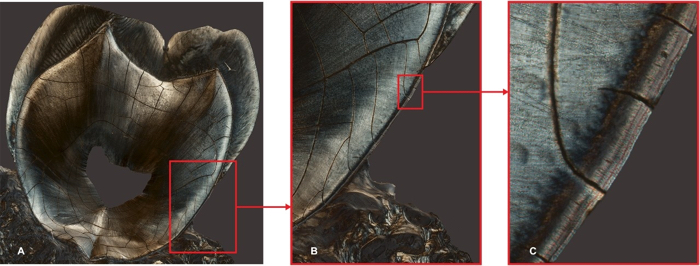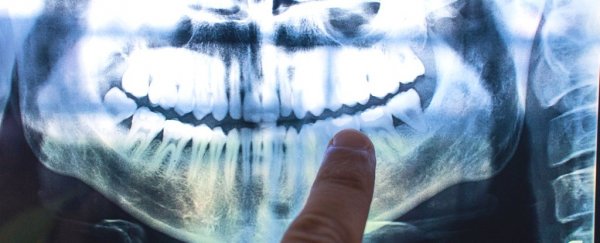Teeth don't just chew. The more we find out about these calcified structures inside our mouths, the more we discover how the oral environment is linked to our broader health, our mental functioning, and much more besides.
Even so, we may have only scratched the surface of how deep the ties go between teeth and the rest of our lives. According to new research, teeth even serve as a silent chronicler of major life events – recording significant, impactful episodes in mysterious 'tree ring'-like bands, hidden inside the microstructure of dental tissue.
"A tooth is not a static and dead portion of the skeleton," explains dental anthropologist Paola Cerrito from New York University. "It continuously adjusts and responds to physiological processes."
 A molar of a 35-year-old female, with close-up revealing dark 'rings' corresponding to reproductive events. (Paola Cerrito)
A molar of a 35-year-old female, with close-up revealing dark 'rings' corresponding to reproductive events. (Paola Cerrito)
In the study, Cerrito and her team analysed 47 teeth from 15 deceased individuals aged 25 to 69 at the time of their death. This cohort, drawn from a cadaveric collection of Central African Malawians of Bantu origin, was chosen because, in addition to their human remains, records exist of most of these people's life histories, including aspects of their lifestyle information and medical history.
In terms of the dental remains, what the researchers wanted to examine in particular was the cementum preserved in the teeth. Like other mineralised tissues such as bone, enamel, and dentine, cementum – a calcified substance that covers the root of each tooth – can record subtle, observable growth lines linked to physiological stressors that impact normal tissue formation.
Unlike enamel and dentine, though, cementum grows throughout our lives, not only while we are young. Because of this longevity, cementum abnormalities can be used as markers indicative of physiological stressors throughout an individual's entire life.
In the case of many mammal species, observations of this phenomenon have helped scientists identify the histological signature of things like pregnancy and lactation – physiologically demanding events in the lifetime of an animal, resulting in narrower cementum growth layers.
What Cerrito and her colleagues wanted to know was whether the same changes in human teeth would correlate with major life events in people's lives, leaving identifiable traces of things like childbirth and menopause.
According to the results, it does. Under the microscope, the team found that cementum markers correlating to reproductive events and menopause were identifiable in the teeth of all the women in the study who had experienced such events – but that's not all they found.
When they compared the documented life histories (largely provided by next of kin) against the dental remains, they discovered other kinds of events also appeared to leave indelible marks in the teeth: systemic illnesses, incarceration, and even moving from a rural environment to an urban centre.
"This tells us something about the 'sensitivity' of cementum as a recording structure: episodic events are not recorded, while prolonged systemic ones are," Cerrito told The Guardian.
Of course, so far, these cementum-based markers have only been demonstrated in a small number of individuals. Before we get too carried away with the potential of the technique, we should wait to see if accurate results can be replicated in a larger group.
There are also limitations to consider in the absence of known life histories. Precisely what might distinguish an event that should have a systemic impact on the body also isn't clear. What could this actually tell us about a John Doe from hundreds of years ago, or even a Neanderthal, if we can't join the dots to any documented chapters of their lives?
For now, there are still plenty of questions, but this could be a discovery set to have a major impact on future research, ranging from archaeology to medicine.
After all, inscribed in each of us, there seems to be a hidden time capsule of life's major moments, preserved in our teeth, and never tapped before now.
"This study provides the first evidence in humans of histological markers corresponding not only to parturitions and menopause, but also illnesses and drastic changes in lifestyle," the team writes.
"Our results demonstrate that dental cementum constitutes a chronologically faithful biological archive of an individual, from which life history milestones, thus far not inferable from other mineralised tissues, can be detected and accurately timed."
The findings are reported in Scientific Reports.
